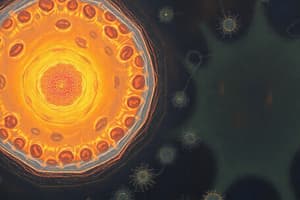Podcast
Questions and Answers
What are the two primary categories of cells based on their internal structures?
What are the two primary categories of cells based on their internal structures?
- Chromosomes and ribosomes
- Cytoplasm and nucleus
- Prokaryotes and eukaryotes (correct)
- Proteins and lipids
Which of the following is a characteristic of prokaryotic cells?
Which of the following is a characteristic of prokaryotic cells?
- Contain nuclei
- Found in humans
- Lack membrane-bound compartments (correct)
- Capable of photosynthesis
What type of cells are responsible for movement and maintaining posture in the body?
What type of cells are responsible for movement and maintaining posture in the body?
- Brain cells
- Muscle cells (correct)
- Nerve cells
- Blood cells
Which organelle is absent in prokaryotic cells?
Which organelle is absent in prokaryotic cells?
What distinguishes eukaryotic cells from prokaryotic cells?
What distinguishes eukaryotic cells from prokaryotic cells?
Which type of cells can be found in humans among the following?
Which type of cells can be found in humans among the following?
What is the main function of sensory neurons?
What is the main function of sensory neurons?
Which cell type is responsible for secreting pigment and protecting from UV radiation?
Which cell type is responsible for secreting pigment and protecting from UV radiation?
What is the function of platelets in blood cells?
What is the function of platelets in blood cells?
What unique function do plastids serve in plant cells?
What unique function do plastids serve in plant cells?
Which structure in plant cells controls stomatal openings?
Which structure in plant cells controls stomatal openings?
How did cell division processes evolve throughout history according to the text?
How did cell division processes evolve throughout history according to the text?
Flashcards
What are cells?
What are cells?
The basic structural and functional units of all known living organisms.
What are prokaryotes?
What are prokaryotes?
Cells lacking a membrane-bound nucleus or organelles; found in Bacteria and Archaea.
What are eukaryotes?
What are eukaryotes?
Complex cells with a membrane-bound nucleus and organelles; found in animals, plants, fungi, etc.
What are muscle cells (myocytes)?
What are muscle cells (myocytes)?
Signup and view all the flashcards
What are nerve cells (neurons)?
What are nerve cells (neurons)?
Signup and view all the flashcards
What are skin cells (keratinocytes)?
What are skin cells (keratinocytes)?
Signup and view all the flashcards
What are white blood cells?
What are white blood cells?
Signup and view all the flashcards
What are red blood cells?
What are red blood cells?
Signup and view all the flashcards
What are platelets?
What are platelets?
Signup and view all the flashcards
What are plastids (chloroplasts)?
What are plastids (chloroplasts)?
Signup and view all the flashcards
What are vacuoles?
What are vacuoles?
Signup and view all the flashcards
What is cell evolution?
What is cell evolution?
Signup and view all the flashcards
Study Notes
Understanding Cells: A Diverse World within Our Bodies
Cells are the fundamental building blocks of all living organisms—a concept first proposed by biologist Theodor Schwann over two centuries ago. These microscopic units are incredibly diverse yet share common features, making them fascinating to explore. In this article, we'll delve into various cell types and their roles within our bodies.
Prokaryotic vs. Eukaryotic Cells
There are two primary categories of cells based on their internal structures: prokaryotes and eukaryotes:
Prokaryotes: Bacteria and Archaea possess simple, streamlined cells without membrane-bound compartments like nuclei, mitochondria, or chloroplasts (in some cases). They lack a true nucleus; instead, genetic material is found freely floating inside the cytoplasm.
Eukaryotes: Animal, plant, fungi, algae, protozoan, and human cells contain complex structures encased in a membrane. Their nucleus and other organelles allow for specialized functions such as energy production, protein synthesis, and photosynthesis.
Types of Cell Specialized Roles
In multicellular organisms like humans, cells specialize according to their function within specific tissues and organs. Some examples are:
Muscle cells: Also known as myocytes, these cells contract and relax to enable movement and maintain posture. There are three main types: skeletal muscles cells, cardiac muscle cells, and smooth muscle cells.
Nerve cells: Neurons transfer information throughout the body via electrical signals called action potentials. Sensory neurons receive stimuli from outside sources, while motor neurons send messages outward to muscles and glands.
Skin cells: Keratinocytes make up most skin cells and contribute to epidermis protection. Other cell types, including melanocytes, secrete pigment responsible for skin color and protect us from UV radiation.
Blood cells: White blood cells fight infection, red blood cells transport oxygen, and platelets prevent bleeding by forming clots when necessary.
Plant cells: Plant cells have specialized structures unique to plants such as plastids (chloroplasts facilitate photosynthesis), vacuoles (store water and nutrients), lignified cell walls, and guard cells controlling stomatal openings.
Evolution of Cells and Division Processes
Throughout history, life evolved from simpler forms to more complex ones with new cell types emerging, reflecting evolution in action. For example, multi-celled organisms developed following single-celled ancestors undergoing binary fission and later developing mitosis and meiosis processes for cell division.
Conclusion
The study of cell biology offers profound insights into basic life functions and formidable challenges for researchers seeking to understand diseases and develop innovative treatments. By exploring the vast array of cell types and their interactions, we can better appreciate the complexity and unity of life itself.
Studying That Suits You
Use AI to generate personalized quizzes and flashcards to suit your learning preferences.




